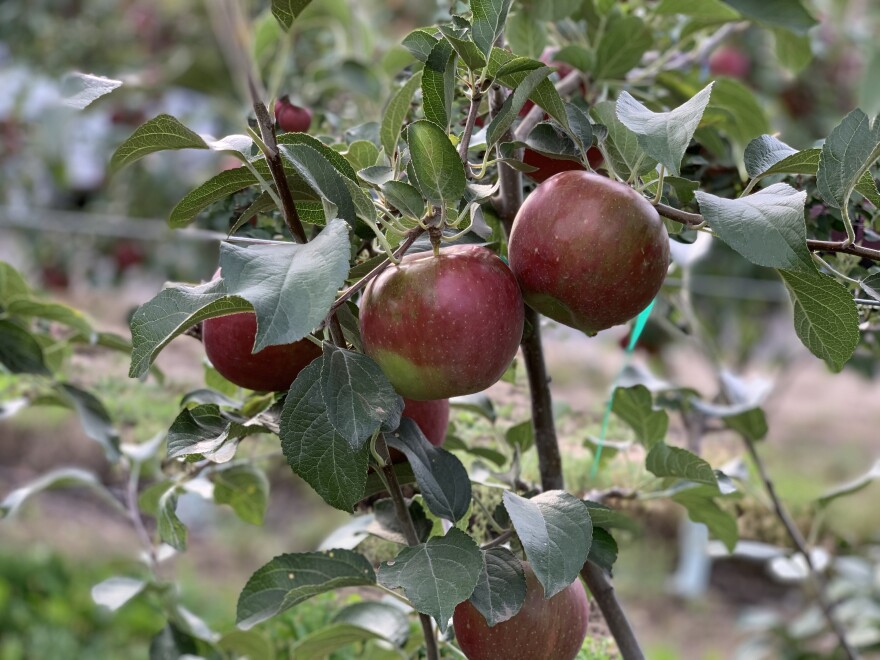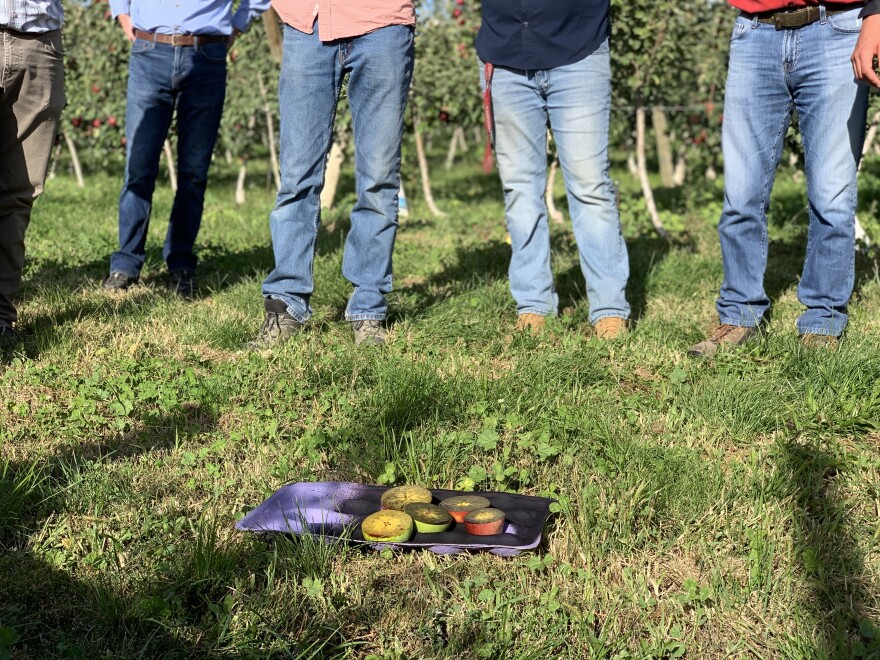LISTEN
Ask Aaron Clark how the Cosmic Crisp harvest is going and he’ll answer with cautious optimism.
“This certainly has an opportunity for broad-base appeal, and everybody’s pretty excited about it. And I am too,” he says, pausing a bit. “But we’ll see.”
Clark is vice president of Price Cold Storage in Yakima and a fourth-generation grower. Simply put, Clark is a businessman. He’s waiting for the apple to hit grocery stores at the end of the year after more than 20 years of development.
But like many growers in the state, Price Cold Storage sees a lot of potential in the apple. They’ve planted about 80 acres of Cosmic Crisp in their orchards. Compare that to the 2,000 acres of tree fruit they harvest, and it may not sound like much.
That’s a lot for a new apple, Clark says, especially considering it takes upward of $35,000 to buy and plant new trees per acre.
Growers don’t make investments lightly.
“It’s a lot of money!” Clark exclaims as workers on tractors haul the harvest away. “The excitement for the apple is proven by how many people are willing to invest that kind of money in something that the public hasn’t gotten to eat yet.”
Genetic Parents
Cosmic is bred from two distinct apple varieties and it takes the best qualities of both.
It’s sweet like its popular genetic parent, Honeycrisp, but by comparison, it’s not as delicate to temperature changes or harsh sunlight and is less likely to develop disorders like ‘bitter pit,’ a calcium deficiency that kills cells in the apple’s skin and flesh, which turn into brown or black spots.
In that sense, Cosmic Crisp takes after its other genetic parent apple, Enterprise, which is hardier but not as sweet.
“I think it’s a beautiful apple,” Clark adds. “I think you walk in the field and they really look nice. But looking nice isn’t as important as them eating well. We’re a for-profit deal, man. We’re looking to make some money on it, and we think we will.”
So far, Clark is impressed by the high yield produced by the young three-year-old Cosmic trees. He expects 50 bins of more than 800 pounds each per acre. The apple will hit grocery stores this December.
That’s after more than 20 years of development by the Washington State University Tree Fruit Research Commission, which has been breeding Cosmic Crisp since 1997. The goal of new variety is to be attractive to consumers, easy to grow and easy to store over a long period of time.
“It’s the trifecta. Usually, you don’t have that,” according to Ines Hanrahan, executive director of the WSU Tree Fruit Research Commission. “This apple, potentially, has all of it.”
Not A Simple Task
But growing apples is still not a simple task, Hanrahan says. Growers still have to get over a learning curve as they get familiar with their new product.
“It’s like any new thing, you have to learn how to handle it,” Hanrahan says. “It doesn’t mean that you can just pluck some piece of wood on the ground and it grows by itself. You still have to manage it horticulturally.”
That’s why the WSU research commission spent weeks ahead of harvest teaching growers how Cosmic Crisp matures on the tree.
If you take a bite out of Cosmic before harvest it tastes and looks like it’s ripe for picking. But Cosmic Crisp matures slowly. That means growers have to rely on an iodine solution spray to see how much starch stored in the apple through photosynthesis has been converted into sugar.
The solution turns sugars dark.
Too much sugar or not enough means the apples might not store as well.
But Cosmic Crisp can run into more serious challenges if not managed well from the start, according to WSU researcher Bernardita Sallato.
The variety is vigorous, meaning it can grow quickly in most soil, but it can grow too quickly as well. If not fertilized properly, mismanaged trees can develop something called ‘blind wood,’ which produces branches with no buds or spores and no fruit.
“It does have challenges,” Sallato says. “But those challenges, it’s important to be aware of those because they can be managed.”
Sallato says most growers have avoided blind wood because its cause and remedy are well known. Older vigorous apples like Granny Smiths and Fujis also suffer from it.
Green Spot
Other issues are harder to manage because they’re not as well understood by science. Take ‘green spot,’ a cosmetic defect that doesn’t change the taste of Cosmic Crisp but could make it hard to sell.
Sallato says it’s probably just like bitter pit in Honeycrisp, caused by a calcium deficiency. But she’s not sure yet. She and other WSU researchers are looking into what factors could be at play.
“Too much nitrogen, too much water, if the rootstock has something to do with that. The spray of calcium,” she said, listing potential causes. “There’s many factors that will be evaluated.”
From Lab To Orchard
Back at Price Cold Storage, Aaron Clark says he hasn’t seen any of those issues. But experience has taught him challenges and unknowns are a natural part of taking an apple from the lab to the orchard.
“There’s a big difference between test blocks in places that (WSU) would do and commercial farming,” he says. “It’s a lot of trial and error. It’s just planting it and seeing where it goes.”
Another unknown is how appealing the apple will be to consumers in a market with a growing number of varieties. Growers are eager to see a good return on investment, especially after trade disputes and rising labor costs have put a strain on their profits.
“But I think they’ll like it,” Clark says. “If I was worried about it, I wouldn’t have planted them.”




